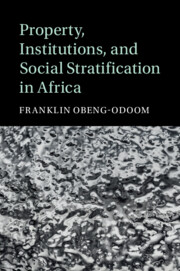Book contents
- Property, Institutions, and Social Stratification in Africa
- Property, Institutions, and Social Stratification in Africa
- Copyright page
- Contents
- Figures
- Tables
- Preface
- Part I The Problem
- Part II Problematic Explanations and Solutions
- 2 Property Economics
- 3 Land Reform
- 4 Human Capital
- 5 International Trade
- 6 Economic Growth
- Part III Alternatives
- Bibliography
- Index
2 - Property Economics
from Part II - Problematic Explanations and Solutions
Published online by Cambridge University Press: 27 March 2020
- Property, Institutions, and Social Stratification in Africa
- Property, Institutions, and Social Stratification in Africa
- Copyright page
- Contents
- Figures
- Tables
- Preface
- Part I The Problem
- Part II Problematic Explanations and Solutions
- 2 Property Economics
- 3 Land Reform
- 4 Human Capital
- 5 International Trade
- 6 Economic Growth
- Part III Alternatives
- Bibliography
- Index
Summary
This chapter investigates whether inequality and poverty worsen or improve over time under the conditions envisaged by de Soto. Existing studies arguing, for example, that the application of de Soto’s thesis creates extra costs for the poor who try to register their urban land and real estate do not address the issue. Additional empirical analysis is needed to investigate what the effect of titling has been on poverty and inequality in Africa. Conceptual answers can be found in the work of Joseph Schumpeter, Henry George, and Karl Polanyi. The three, whose work, respectively, on innovation and entrepreneurship as drivers of economic development, on the role of economic rent in economic development, and on the role of “fictitious commodities” and the “double movement” in shaping the dynamics of capitalist economic development, bear directly on de Soto’s claims. While, on the surface, the work of Joseph Schumpeter may be taken as confirming de Soto’s thesis, that of Henry George and Karl Polanyi demonstrates that de Soto’s thesis is fundamentally flawed. A critical analysis and synthesis of these seemingly differing conclusions, however, reveals that applying de Soto’s ideas through policy would be ineffective, and actually serve to simultaneously entrench and augment inequality.
Keywords
- Type
- Chapter
- Information
- Publisher: Cambridge University PressPrint publication year: 2020

